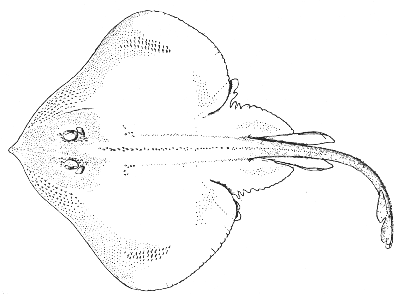Smooth-tailed or prickly skate Raja senta Garman 1885
[Bigelow and Schroeder, 1953, p. 264.]
[Garman, 1913, pl. 25, fig. 1.]

Figure 30.—Smooth-tailed or prickly skate (Raja senta), male, about 20½ inches long, Emerald Bank, Nova Scotia. From Bigelow and Schroeder. Drawing by E. N. Fischer.
Description—
By the time this skate has grown to one-fourth its adult size it is made recognizable by the fact that the middorsal line of thorns runs back only to about the middle of the tail, where the thorns so dwindle in size that they are not distinguishable from the tiny prickles with which the tail is clothed, generally. Newly hatched specimens in which this character is not yet established are separable from all other Gulf of Maine skates by the color pattern of the tail, which has two pale crossbars, each outlined in front and behind by a dark band or blotch.
There is a single row of 16 or more medium sized to large thorns along the midline of the back, spaced irregularly, and usually about 20 to 30 along the anterior one-half or so of the tail; about 10 to 13 around the inner ridge of each eye; and 3 to 5 on each shoulder. Immature specimens of both sexes are also closely and uniformly roughened with small prickles over the disc as a whole, on the pelvics and on the upper side of the tail. But irregular bare areas develop on the shoulders and around the outer parts of the pelvics of females as they approach maturity while mature males lose the prickles from the central part of the disc as a whole, but develop a few thorns on the mid-ridge of the snout besides larger thorns over a roughly triangular area on either side of the head abreast of the eyes and farther forward. They also develop two rows of the usual curved sexual spines on either side on the pectorals, about 13 to 14 per row. The lower surface of the disc is smooth, except that a few prickles develop, with growth, along the margins near the snout.
The lower surface of the tail as a whole is prickly on females and on immature males, but tends to become smooth on males by the time they mature sexually.
The anterior angle of the snout is a little more obtuse than a right angle (about 110°); the tip of the snout is sharper than in either the big skate, the little skate, or the thorny skate. There are 38 to 40 series of teeth in the upper jaw, 36 to 38 series in the lower jaw; those of females are low, with only faintly indicated points, but those of mature males are longer, sharper, recurved, and [page 71] spaced more loosely. There is no free space between the two dorsal fins. The disc is a little broader than long (1.2 to 1.3 times); the tail occupies about one-half of the total length.
Color—
The upper side, including the tail, is pale brown, with many obscure darker spots. Newly hatched specimens are also marked on the tail with two pale cross bars, each outlined by a darker cross bar or blotch in front of it and one behind, but these bars disappear with growth. The lower surface is white, either plain or with a few dusky blotches. Sometimes the rear part of the tail is uniformly dark below.
Size—
A male about 20 inches (515 mm.) long that we have seen seems to be sexually mature. The largest specimen of which we have record was 24 inches long.
Habits—
This skate appears equally at home on the soft mud and clay bottoms of the deeper basins of the Gulf and on the sand, broken shells, gravel and pebbles of the offshore fishing banks. Nothing is known of its diet. Egg cases, apparently of this species, have been trawled in deep water (82-164 fathoms), in the estuary of the St. Lawrence River in July and August; probably they are laid in summer in the Gulf of Maine, as well.
General range—
Atlantic shelf of North America from the offing of Charleston, S. C., to the Nova Scotia Banks and Gulf of St. Lawrence, a few reaching the southern part of the Newfoundland Banks; mostly in depths greater than about 40 to 50 fathoms. The deepest record for it is 478 fathoms off South Carolina.
Occurrence in the Gulf of Maine—
This skate, once considered a rare species, is now known to occur generally throughout the western side of the Gulf wherever the water is more than 45 to 50 fathoms deep, 25 fathoms being our shoalest record for it and on the offshore Banks as well. We have trawled it on several occasions in the deep trough west of Jeffreys Ledge; in deep water (80-100 fathoms) near Cashes Ledge; also in the basin east and southeast of Cape Cod. And, being known from the southeastern slope of Browns Bank, it is to be expected generally in the eastern side of the Gulf, as well as in the western, at the proper depth. It is widespread on Georges [page 72] Bank also, but is far less plentiful there than other skates, to judge from the fact that trawl hauls in September 1929 brought in only 37 of them, and that we counted only 8, from 42 hauls on the Eugene H; in June 1951, fishing from Nantucket Lightship to the south central part of Georges. We have trawled it at 50 to 250 fathoms off southern New England. To the eastward and northward, it is recorded on La Have and Emerald Banks at 50 to 100 fathoms, and in the Gulf of St. Lawrence at 82 to 178 fathoms.